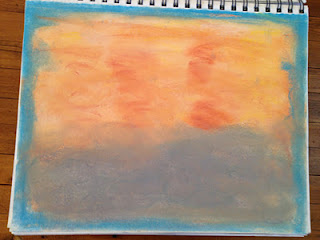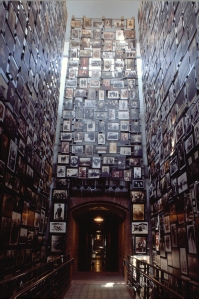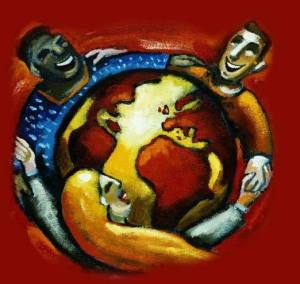We are pleased to bring you this guest post from our new friend Elf Lady. Her post originally appeared here on her blog Elf Lady’s Chronicles, where she shares personal stories of surviving domestic violence, divorce and motherhood. Elf Lady’s blog is wonderful narrative of her journey in healing, we think you’ll enjoy reading her work.
**********************************************************************************************
“Art opens the closets, airs out the cellars and attics. It brings healing.”
-Julia Cameron
As women we are artist of our own lives. We exercise our creativity by providing healthy, hearty meals for our family, creating a cozy home, planning birthday parties and organizing holidays. We are constantly creating. In addition, women are the natural nurturers and healers in our society. So what happens when we need to be healed? What happens when we need to be healed of the trauma and abuse we have experienced at the hands of an intimate partner?
As a survivor of domestic violence myself, my therapist, Michelle, recommended journaling as a means to deal with the emotions surrounding my abusive relationship and pending divorce. I tried journaling, but it was too painful writing down my thoughts. However, I knew from my sessions in Michelle’s office, her specialty was art therapy.
What is Art Therapy? According to the Art Therapy Alliance, art therapy is “the deliberate use of art-making to address psychological and emotional needs. Art therapy uses art media and the creative process to help in areas such as, but not limited to: fostering self-expression, create coping skills, manage stress, and strengthen sense of self. Art therapy has provided mental health treatment for clients who have experienced trauma, grief & loss, depression, chronic illness, substance abuse, and more.”
Michelle works with foster kids from abusive homes and other children dealing with various challenges. She predominately uses art therapy for these children and teenagers as a means in dealing with their pain. Her office is filled with pastels, paints, markers and sketchbooks. The office walls are painted with colorful, bold pictures of flowers, vines, phrases, bricks and snowmen. The paintings give me a sense of comfort and warmth regardless of not contributing to the collage of images myself.
I had been seeing Michelle for six months before I asked if I could try Art Therapy. I considered myself a creative person. As a child I sketched eyes and faces and wrote poetry, but that ended as I entered college to become an engineer. Today my creativity is expressed through every day activities such as cooking, decorating, gardening and at times photography. I know I don’t have the skills to be a true artist, and that’s okay. Art therapy does not require skill. It only requires you to try.
Gretchen Miller, MA, ATR-BC, CTC, writes, “Through art-making, survivors can make sense of and find their way out of chaos, frightful memories, and the raw emotion of their abuse to discover a sense of grounding, strength, safety, understanding, and hope.”
So I bought a pack of pastels and got out my sketch book. One of the first pictures I drew in my sketchbook was of my husband.
I wanted to draw a picture showing how I saw him that night and other nights when he was angry. The dark blue is the coldness in his heart, my feeling of dread, and the darkness of my depression. The fire represents how quickly my husband could explode transforming himself from a civil, normal man to a heartless, angry monster.
My next attempt expressed my feeling of being shattered and surrounded in a sea of chaos. My marriage was shattered, my sense of self was shattered, my belief system was shattered. Things I believed to be true were no longer true, so what was real and what was not? Who or what could I believe anymore?
After these short drawing sessions, I was always a little more at peace. I felt a sense of relief getting these pictures and feelings out of my mind and soul and onto paper.
Although I could not afford it, in August I decided to rent a beach cottage for the week before my son returned to school. He brought his beach toys, matchbox cars, and books. I armed myself with my sketch book, pastels, and colored pencils in addition to my self-help books, camera, sunscreen, and beach chair.
The sound of the ocean and the warmth of the sun has its own healing properties. Sitting on the beach listening to the waves and watching my son play in the water, I could finally relax. I began to capture this peace and solitude with my pastels and pencils.
I first drew the view from the front porch of our little cottage. I could sit on the porch in my rocking chair and watch the breeze blow the dune grass and lines of pelicans fly by. Often I would see fishing trawlers and sailboats in the distance.
Another favorite pastime that week was searching through the vast amounts of seashells deposited on the sand after high tide. There were so many shells it looked like a dump truck had driven on the beach in the night and unloaded an entire load of beautiful, multi-colored seashells.
The sifting and searching for my favorite shells became meditative and therapeutic for me. I was fascinated by the palette of colors nature applied in creating the shells. So, one night while sitting at the kitchen table, I laid out an assortment of my shells and captured their colors on paper. Using pastels, I was able to blend the colors into shades that matched my shells. I realize my drawing doesn’t look like much, but I was pleased with the result and looking at the colors has a calming affect for me.
My last drawing at the beach was a sketch in a struggle to find some peace and solitude one day. As I drew this scene of my beach chair and umbrella, I was in reality having an anxiety attack.
My mom had decided on her own to follow us to beach for four days during the time my son and I were there. Upon arrival, she proceeded to take control of my son and whisk him away for putt putt golf or swimming at the pool of the condo where she was staying regardless of any plans I may have had. While I was grateful for the time my son was able to spend with his grandmother and the hour or two for a long walk on the beach, I felt these decisions were made for me and my peaceful vacation had been hijacked by my mom. Striving to set boundaries, we eventually had words resulting in her leaving in a huff. But I was much relieved to have regained control of my vacation.
Coming full circle, I want to share a drawing of one of my injuries I received the last night my husband assaulted me. I did not draw this until the end of September, a full nine months after the assault. Creating this drawing was triggered by registering for a 5K benefiting Interact of Wake County, the local non-profit supporting victims of domestic violence. As a survivor, I felt a duty to run in this race. In the days leading up to this race, I started to relive that night. I felt the sense of betrayal and shame all over again. Finally, I decided to capture what happened that night on paper, hopefully coming to terms with it in some fashion.
My sketches have brought me peace during and after drawing. At times, the drawing has brought clarity to how I felt about my abusive relationship. At other times the benefits of drawing cannot be put into words, but I know a small tectonic shift has occurred leading me further along my path of recovery.
While we may never pay our bills with our endeavors of painting, drawing, or sculpting, we are all artists of our own life. Every day we create a beautiful mosaic of our lives with connections to our loved ones, our friends, our hobbies and passions, and events in our life.
As women, we are accustomed to the art of creating and the art of healing. We create nutritious meals for our family, beautiful gardens, and cozy, inviting rooms for our homes. We heal our children when sick, our partners and friends when they are down and out. Why not combine these two worthy and natural skills to heal ourselves through art?



















 therapy with art making. Art therapy, based on knowledge of human developmental and psychological theories, is a form of therapy that uses the creative art making process to help individuals express feelings, gain insight, resolve conflict, solve problems, explore difficult issues, increase self-esteem, reduce stress and manage behavior.
therapy with art making. Art therapy, based on knowledge of human developmental and psychological theories, is a form of therapy that uses the creative art making process to help individuals express feelings, gain insight, resolve conflict, solve problems, explore difficult issues, increase self-esteem, reduce stress and manage behavior. Art therapy has been used with a wide range of people, from young children to the elderly, with a broad range of experiences. Some examples of how art therapy has been used include work with
Art therapy has been used with a wide range of people, from young children to the elderly, with a broad range of experiences. Some examples of how art therapy has been used include work with